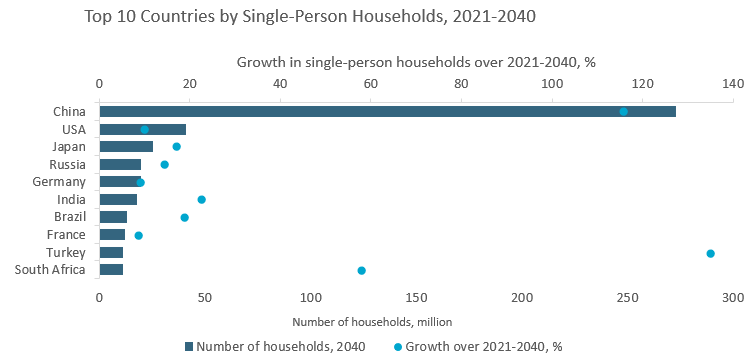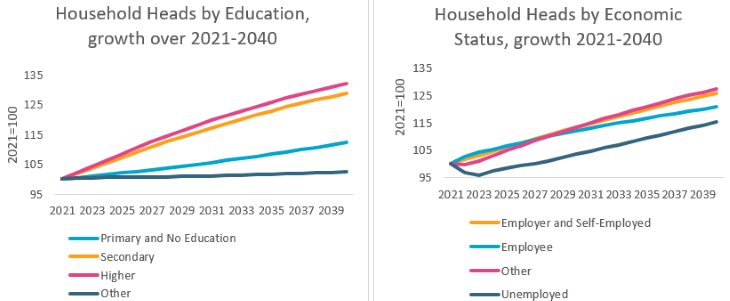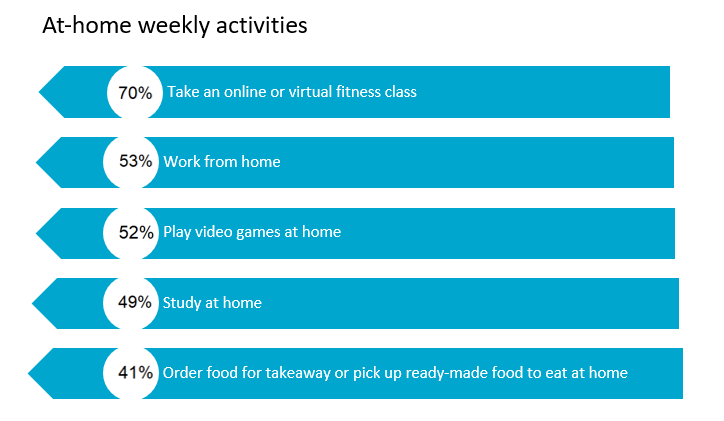The composition of global households is being reshaped. Consumers increasingly live alone and want to engage in reality-like experiences at home. Nevertheless, the mismatch between household heads’ education and employment levels is becoming more pronounced. This article will explore the top three household trends that companies should consider for future opportunities.
1. The rise of single-person households
The number of single-person households is rising at the fastest pace among all household types, influenced by shifting global demographics. Due to ageing populations and growing longevity, an increasing number of seniors are left without their spouses, and spend the rest of their lives living alone. As of 2040, people aged 65+ are expected to constitute 15.0% of the global population (up from 9.7% in 2021). Moreover, people are getting married later, prolonging the period of living alone for the younger generations. The average age at first marriage is rising, and is expected to shift from 24.2 in 2021 to 25.0 in 2040 for women, and from 27.2 to 28.2 for men. Moreover, the number of divorcees is expected to rise by 13% globally over 2021-2040, with many choosing to live alone after moving out.
Overall, being single has become more of a norm, with many embracing single positivity and focusing on career, friendships, self-fulfilment and personal freedom. To keep up with the rising number of single-person households, companies are introducing household solutions tailored for solo use. For example, Airbnb has launched a new residential singleton-oriented service, Célib Yeoui, in South Korea, providing the opportunity to rent a “sample of homes” before signing a longer-term contract, while Amazon has opened a store for space-saving furniture, offering multipurpose and compact pieces for those who live in small apartments.
By 2040, the number of single-person households is expected to more than double in China, sustaining its ranking as the largest singletons market, followed by the US and Japan. More can be found on households in China, the US and Japan.

2. More education, more unemployment
Educational attainment is on the rise across the world, due to increasing incomes, roaring digitalisation, improving education reach, and higher government focus. People are also increasingly embracing lifelong learning to grow and succeed personally and professionally, and to stay relevant in constantly evolving workplaces. As a result, the number of household heads with higher education increased by 86% over 2000-2021, and is expected to rise by 32% over 2021-2040 globally.
Nevertheless, more education does not necessarily mean better-quality education. It also does not mean better employment opportunities. Over 2000-2021, the number of unemployed household heads increased by more than 57%, and is forecast to grow by another 15% by 2040. The reasons for the mismatch between education and employment levels lies in inefficient and rigid education systems, that often fail to satisfy the future needs of businesses, affecting their ability to keep up with technology and innovate. Lack of relevant skills and higher employee turnover also leads to lower productivity, resulting in a lack of competitiveness and, potentially, lost profits.
According to a survey undertaken by the European Centre for the Development of Vocational Training, many employers are concerned that applicants lack soft skills that enable them to effectively communicate and solve real-world problems. To address such concerns, Ashoka Changemaker School in the Netherlands, for instance, has introduced a curriculum giving skills such as problem-solving, social skills, collaboration, creativity, communication technology (ICT) and lifelong learning the same importance as reading and maths.

Source: Euromonitor International from national statistics
3. Home for everything
The COVID-19 pandemic has resulted in an unprecedented rise in the amount of time spent at home, with consumers embracing a variety of in-home activities. The push towards working, studying and entertaining from home has led to growing demand for digital solutions and consumer appliances that enable better, easier and seamless at-home experiences. Although the primary digital adopters are younger generations, silver consumers present a large untapped cohort, and also a high willingness to go digital.
With 70% of global consumers stating they take an online or virtual fitness class at least once week, the wellness at home trend has been widely embraced, with fitness companies increasingly coming up with solutions for realistic and engaging workouts at home. For example, Liteboxer, an at-home fitness company, has built a new virtual reality (VR) app for a sports-at-home experience, offering daily trainer-led workouts that are motivating, interactive, and full of immersive experiences.

Global household trends raise several implications that businesses must recognise to sustain their success in global markets.
- The growing popularity of single living is resulting in an increasing number of goods and services being tailored for solo use, with more compact and functional appliances at the forefront of the trend.
- Starting from the K-12 or school education, the traditional focus on basic academic skills, role learning, and standardisation is becoming obsolete and replaced by digital and soft skills, such as emotional intelligence, resilience and creativity.
- As in-home activities are more valued than ever, consumers are striving for products and services that evoke more social interaction and make in-home activities more reality-like.
For further discussion on this topic, read our report, Global Household Trends.
